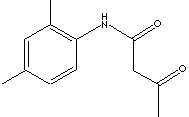PRODUCT IDENTIFICATION

202-576-0
2924.29
Oral rat LD50: 800 mg/kg
CLASSIFICATION
PHYSICAL AND CHEMICAL PROPERTIES
89 C
1.24
REFRACTIVE INDEX
GENERAL DESCRIPTION & APPLICATIONS
Acetoacetates have a reactive hydrogen atom on the carbon alpha to both carbonyl groups. It undergoes Knoevenagel condensation reaction as a reactant to forms a large class of target products including amino acids, drugs, colorants, lacquers, perfumes, and plastics. Alone, it is used as a flavoring agent and a solvent. Knoevenagel condensation is a nucleophilic addition of a reactive hydrogen atom at 1,3-diketone compounds to a carbonyl group, followed by an dehydration reaction. 1,3-Diketone compounds (beta-ketones) include malonic acid, diethyl malonate, Meldrum's acid, and acetoacetic acid derivatives.
AAMX is used in manufacturing agricultural chemicals, coating materials, dyes and pigments, pharmaceuticals, co-promoters for polymers.
APPEARANCE
White to off white powder
99.0% min
MELTING POINT
88 C min
MOISTURE
0.2% max
IRON
0.5ppm max